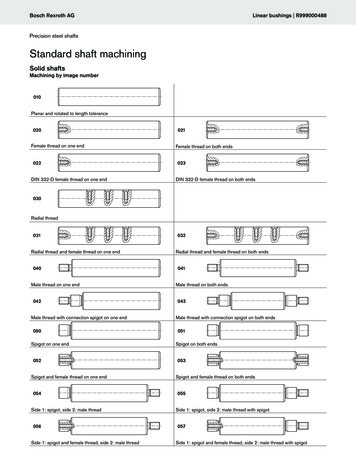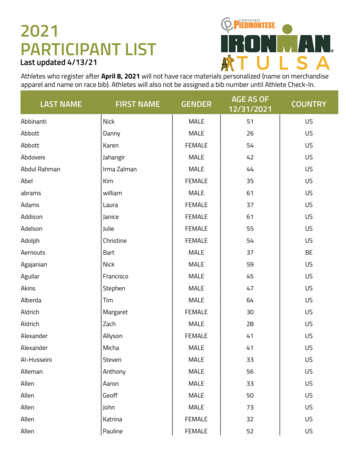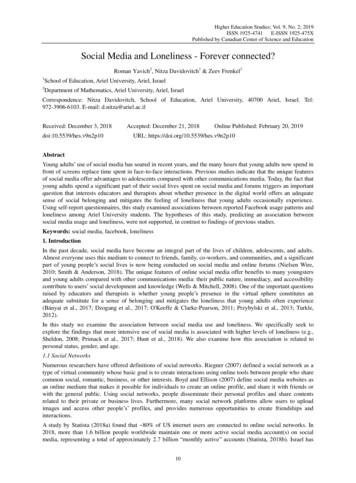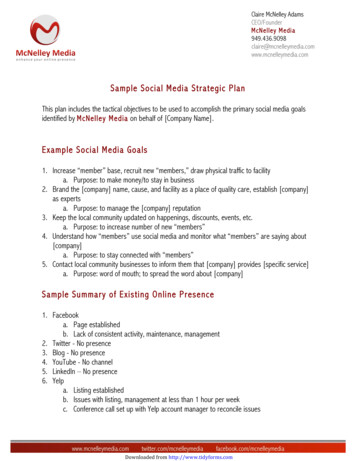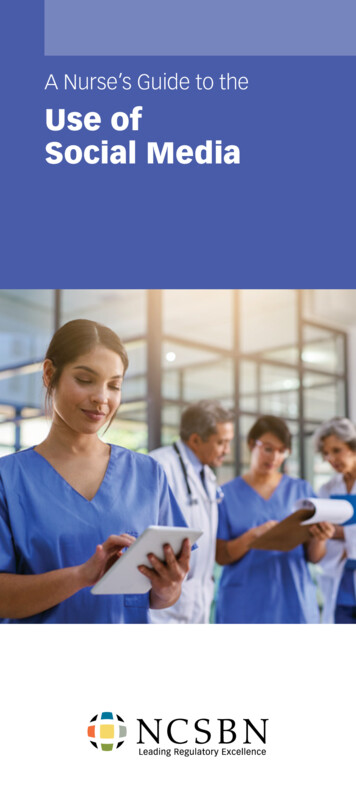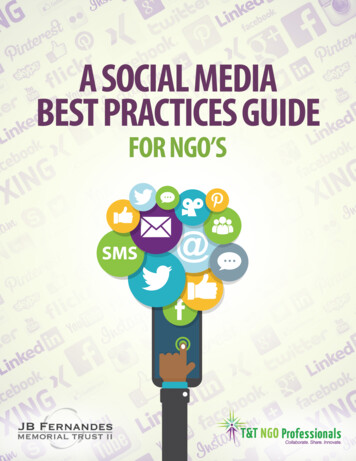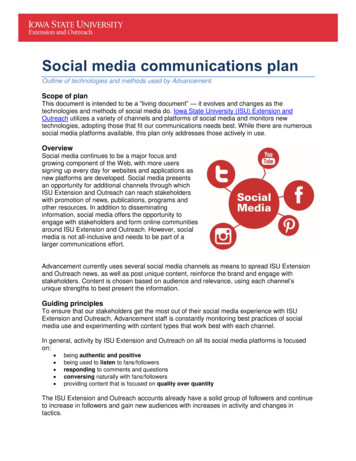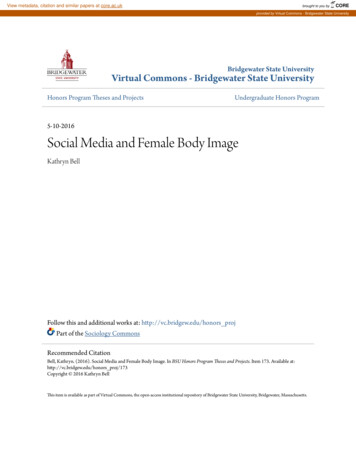
Transcription
View metadata, citation and similar papers at core.ac.ukbrought to you byCOREprovided by Virtual Commons - Bridgewater State UniversityBridgewater State UniversityVirtual Commons - Bridgewater State UniversityHonors Program Theses and ProjectsUndergraduate Honors Program5-10-2016Social Media and Female Body ImageKathryn BellFollow this and additional works at: http://vc.bridgew.edu/honors projPart of the Sociology CommonsRecommended CitationBell, Kathryn. (2016). Social Media and Female Body Image. In BSU Honors Program Theses and Projects. Item 173. Available at:http://vc.bridgew.edu/honors proj/173Copyright 2016 Kathryn BellThis item is available as part of Virtual Commons, the open-access institutional repository of Bridgewater State University, Bridgewater, Massachusetts.
Bell 1Social Media and Female Body ImageKathryn BellSubmitted in Partial Completion of theRequirements for Departmental Honors in SociologyBridgewater State UniversityMay 10, 2016Dr. Kim MacInnis, Thesis DirectorDr. Michele Wakin, Committee MemberDr. Kimberly Fox, Thesis Director
ABSTRACTBell 2Social media has grown in popularity over the past few years and seems to be almosteverywhere in society. This research analyzes connections between the increased availablesocial media outlets and one’s own perception of their body in relation to what they are seeing insocial media messages and images. The main focus is on female body image and whether or notsocial media causes negative body image and body dissatisfaction. A survey was constructed tocollect data on current female college students and their perceptions of body image.Participation in the survey was anonymous and voluntary. Participants were female collegestudents ranging between the ages of 18-23 who are members of the Phi Sigma Sigma sorority atBridgewater State University. In addition to the data from the survey, additional research wascollected and analyzed from academic sources, articles, and books that further supported theresearch question. The research and data look at how female body image differs and isinfluenced by the social media outlets that participants are exposed to. Many findings concludedthat there is a correlation between social media and negative body image but social media doesnot directly cause negative body image. Rates of negative body image among social media userswere higher based on the user’s own internalization of messages and images. The higher one’sinternalization level, the more likely they were to experience negative body image and bodydissatisfaction.
INTRODUCTIONBell 3Social media has continued to grow in popularity since its introduction to society andsince then numerous different types of social networking sites have been created. Another risingstatistic that has caught the attention of researchers is the number of eating disorders and bodydissatisfaction rates. This has caused many researchers to begin looking at possible connectionsbetween the two and whether social media is influencing the way people view their bodies,especially women, and whether it is causing them to develop negative body image or eatingdisorders (Klein 2013).One social media star brought attention to the influence that these unattainable beautystandards could have on one’s own opinion of their body as well as other’s opinions. Cassey Hois a beauty/fitness blogger and YouTuber. She receives hundreds and thousands of commentsevery day on the content she posts to her YouTube channel, blog, and social media sites. Toshow how focused society has become with physical appearance and the influence that socialmedia can have, Ho decided to do an experiment on her Instagram account. She took all of thecomments that people were making about her body and how it should look and photo shopped animage of herself matching all of those comments. She then posted this photo to her Instagramaccount claiming she had finally reached the perfect body. According to the original comments,this image portrayed a perfect body (Ho 2015).The results of this experiment were surprising. There were numerous comments stillclaiming that her body did not match the beauty standards created by society. They were tellingher that she still was not thin enough and that her body did not look good while others werepraising her for losing so much weight so quickly and asking for her secret. The secret? Photoshop. It was interesting that there were still negative comments because she did create a photo of
Bell 4the perfect body according to original comments, so does the perfect body not even exist? Shethen took to her blog and YouTube channel to post a video about this experiment and highlightedthe dangers of these unattainable beauty standards and the relationship they have with socialmedia (Ho 2015).This particular story stands out because it shows how obsessed society has become withthis idea of a perfect body while also showing the power of social media and commenting. Thistype of situation creates interest in researching the relationship between social media and bodyimage because some individuals could be greatly affected by such online negativity. Could thistype of negative attention towards body image lead to body dissatisfaction and eating disorders?
LITERATURE REVIEWBell 5WHAT IS SOCIAL MEDIA?Social media is a subset of mass media that has experienced an increase in use as theInternet has grown in popularity and commonality (Jurgens 2012). This is particularly true inWestern societies such as the United States. Social media and social networking are both usedinterchangeably to represent the many online communities that exist in today’s society and socialgroups (Jurgens 2012). These networks are used to facilitate communication and interactionbetween people in a purely online sense and not face-to-face situations. According to del FresnoGarcia et al. (2016, p. 24), “social media are online technology platforms focusing onsynchronous and asynchronous human interactions with a local and global reach unprecedentedto human history.” Social media is a form of communication and connectedness that society hasnever seen or experienced until now and is growing in popularity, which is increasingresearchers interest in studying its effects especially of body image (Klein 2013).The Internet and social media have become increasingly relevant parts of people’s livesand can be acquired in more areas than ever before (Jurgens 2012). Bell & Dittmar (2011, p.478) suggest that, “the popularity and availability of more interactive media is increasing.”People can access the Internet from almost anywhere at anytime of the day to connect withanyone around the world (Klein 2013). This makes it easier and more convenient to accesssocial media sites. Many of these social media outlets can include, Facebook, Twitter, Instagram,blogging/vlogging, YouTube, Snapchat, etc. Having unlimited access to social networking andbeing able to analyze these interactions has been titled infosociability (del Fresno Garcia et al.2016). According to del Fresno et al. (2016, p. 25), infosociability has led to two phenomena,“on the one hand, the rise of mass auto-communication, and on the other, that every individual
Bell 6has the potential to become a source of micro-media at the same time the media and part of themessage.” These phenomena will allow researchers and media users to identify and addresssocial and communication problems within the world of social networking (del Fresno et al.2016).Many researchers have suggested that social media will become a new outlet to connectall types of media so users can access more mass media than originally available through socialnetworking. Social media services are always changing and adapting to cater to newer, largeraudiences so it is estimated that social networking will become a valuable mass media tool (delFresno Garcia et al. (2016). Del Fresno Garcia et al. (2016, p. 25) describes social networkingas, “a media of intersection of every media and medium,” and within social media there is apossibility to post links, videos, and images from other media outlets. Having social media as anoutlet to all types of media allows for them to further influence social media users beyond justsocial networking sites.Social media has great influence over many users especially when they are engaged incommunication and activity surrounding a popular media figure, such as celebrities or socialnetwork stars. Del Fresno Garcia et al. (2016) has labeled these types of figures as opinionleaders because they have strong influence over other social media users who view them as rolemodels and often copy their actions. These figures are, “portrayed as having significantinfluence over others as they selected, modified, and transmitted information/messages of theirchoosing to the wider public- in essence controlling both the means and the message” (delFresno Garcia et al. 2016, p. 25). Therefore these opinion leaders have the power to portraymessages that may be positive or negative. Many of these messages have the potential torepresent negativity towards topics such as body image and body dissatisfaction. Some of these
Bell 7social media influencers highlight their diet, exercise, and lifestyle to readers and fans, which cancreate the idea that viewers need to do these certain things to look like their favorite celebritiesand attain the ‘ideal’ body. Researchers have begun looking into the possibilities of social mediaincreasing negative body image and eating disorders, particularly among women. Since socialmedia is a newer outlet for mass media, the research on this topic is relatively new oncontinuously ongoing.BODY IMAGE & THE ‘IDEAL BODY’Body image is the way one views themselves and their own bodies, sometimes in relationto others. It can be defined as, “a multidimensional concept that encompasses perceptual,cognitive-affective, and behavioral domains” (Ridolfi et al. 2011). When body image isdiscussed and researched, it is usually in terms of negative body image. Negative body imagecan be defined as, “the psychologically salient discrepancy between a person’s perceived bodyand their ideal body, which manifests itself as the experience of negative thoughts and esteemabout one’s body and appearance” (Bell & Dittmar 2011, p. 479). Negative body image iscommonly associated with body dissatisfaction. Ridolfi et al. (2011, p. 491) defines bodydissatisfaction as, “the cognitive-affective domain of body image, refers to negative anddysfunctional cognitions and emotions about one’s appearance.” Negative body image hasbecome more common on an international level as western media has globalized (Ridolfi et al.2011).Negative body image and body dissatisfaction are major risk factors for eating disordersas researchers have seen the number of eating disorders, particularly in young women, increaseof the past few decades (Ridoli et al. 2011). According to Bell & Dittmar (2011), concernregarding negative body image in young females is increasing in many Western countries such as
Bell 8the UK, the United States, and Australia. They also suggest that, “body dissatisfaction anddisordered eating behavior are believed to have reached normative levels” (Bell & Dittmar 2011,p. 478). Over 90 percent of young collegiate women in the United States report having body andweight dissatisfaction (Pritchard & Cramblitt 2014). According to Klein (2013, p. 27), “thestrong emphasis placed on social networking and photo sharing can only build on the alreadyexistent phenomenon of social psychology, sociology, and media effects theories that helpexplain body dissatisfaction and disordered eating.”Mass media overtime has developed this idea of what the perfect female body should beand what it should look like. Social media reinforces this idea of an ideal body since it can beconnected to almost all outlets of mass media. Everything from height, weight, bodymeasurements, and body shape has become an intricate part of this ideal. Women are mostcommonly the targets of these ideal body portrayals and advertisements. They are taught thatthey should aspire to be extremely thin. Many of these ideals are, “impossible for many peopleto realistically and healthily achieve” (Pritchard & Cramblitt 2014, p. 209). Many of theindividuals that the media presents as having ideal bodies are models, actresses, and celebrities.In the United States the majority of female models are 15 percent below the average femaleweight and 95 percent of actresses are thinner than the average woman (Pritchard & Cramblitt2014 & Yamamiya et al. 2005). These types of bodies and advertisements are telling womenthat they should work towards being thinner and weighing less than the average woman, whichcan be extremely unhealthy. According to Ferguson et al. (2013, p. 2), “increased incidence ofeating disorders across the early and mid-twentieth century seem to coincide with trends in themedia towards emphasizing thinness in women.”
Bell 9Social media often blurs the line between virtual and reality therefore creating ideas thatwomen should look like the images they are viewing (Klein 2013). Women are constantly beingtaught that the only way to be successful in their life is to look like the women they see in media.Females experience these pressures as well as body dissatisfaction at higher rates than males(Helfer & Warschburger 2013). According to Klein (2013), 74 percent of all women participatein social networking therefore increasing their exposure to these ‘thinspiration’ images. Sincesocial media is all about interaction, they are feeling the pressure more from these networkingsites than other sources of media (Ridolfi et al. 2011). Since these ideals are being associatedwith success and happiness, women are, “more likely to report wanting to lose weight (drive forthinness)” (Pritchard & Cramblitt 2014, p. 208). Women of normal, average weight are beingtold that they are not thin enough and weigh too much. This is disconcerting especially since theaverage weight for women today is 166.2lbs and therefore higher than what is being portrayed as‘ideal’ or ‘perfect’ (Coren 2015). The widening gap between the size of the average woman andthe media’s ideal woman is concerning for researchers who believe it could be related to higherlevels of body dissatisfaction and negative body image (Klein 2013).Initially when the ideal body was presented on social media, being thin was greatlyemphasized. Over the past few years, there has been a shift in the image of an ideal body forwomen that focuses more on fitness. Women are no longer pressured to just be thin but are alsopressured to be firm and toned (Pritchard & Cramblitt 2014). Pritchard and Cramblitt (2014)discuss how muscularity is becoming the new ideal body for women and that Western societyhas begun emphasizing physical exercise as part of the ideal lifestyle to go along with the idealbody. Muscularity is often associated with masculinity so the ideal female body is shiftingslightly towards a more masculine look by promoting muscular, toned bodies.
Bell 10Since physical exercise has become a more important and pressing part of this new typeof ideal body, there is increased pressure for women to work on their fitness. Women feel asthough they need to spend more time focusing on their physical fitness and join gyms/fitnesscenters (Prichard & Tiggemann 2012). Even though women are feeling as though they need tospend more time at the gym, researchers found that there is a strong correlation betweenexercising at fitness centers and increased body image concerns and eating disturbances(Prichard & Tiggemann 2012). Social media outlets are telling women to increase their fitnessregimen while simultaneously increasing their body dissatisfaction when working on theirfitness. Therefore women are stuck with this feeling of wanting to become more fit but areintimidated to go to fitness centers. Prichard and Tiggemann (2012) found that fitness centerstend to have images that portray the ideal body in ways that pressure women to be more bodyconscious when around these images in gyms. They feel that if their bodies do not look likethese images then they will be judged by others at these fitness centers. They also feel that theywill be judged if their bodies do not match the ideal body suggested by social networking outlets,therefore adding to the anxiety of attending fitness centers (Prichard & Tiggemann 2012).This new type of ideal body has been developed from just being thin to being both thinand muscular. The rise of popularity in fitness blogging and vlogging, newer types of socialmedia, has been connected to this new type of ‘ideal body’. Vlogging represents video bloggingand many creators have begun creating videos surrounding health and fitness, and how to get thatperfectly fit body. Videos have become an increasingly popular part of social media (Prichardand Tiggeman 2012). These types of videos and blogs can be found all over the Internet buthave become the topic of discussion by researchers as to whether or not they promote healthyliving or the unattainable ideal body.
INTERNALIZATIONBell 11As social networking popularity has increased overtime, many researchers are turningtheir attention to studying the connections that may exist between social media influence andbody image and eating disorders. Bell & Dittmar (2011, p. 478) found that, “exposure to thin‘body perfect’ ideals in the media is strongly related to negative body image in girls andwomen.” Body dissatisfaction is often correlated with the drive for thinness and the ideal body(Bell & Dittmar 2011). It is true that correlation is not causation so many researchers suggestthat there is not a direct cause between social media and the development of negative body imageand body dissatisfaction, but rather it depends on one’s internalization of the material beingpresented.Some women internalize information, especially regarding body image, more than otherwomen. Those who internalize information more than others are at an increased risk ofexperiencing negative body image and body dissatisfaction (Ridolfi et al. 2011). Womenreported being significantly more dissatisfied with their own bodies after viewing thin andbeautiful images and messages than after viewing average size or oversize ones (Yamamiya et al.2005). Some women internalize information more than other women and it all depends on howone interprets the messages and images being presented to them through the social networkinggroups they belong to. Although Yamamiya et al. published their work in 2005, Klein (2013)discusses how these theories and claims are still very true in today’s society.Klein (2013) discusses how younger generations are experiencing increased accessibilityto social networking and the Internet while also facing the increasing desire to belong tonumerous different social media sites. This is increasing their exposure to image heavy socialmedia such as Instagram and Snapchat, which both only use, post, and share images. This
Bell 12creates networks that focus primarily on image and can contribute to the idea that women need tolook like what they see in photos, especially of celebrities and popular figures. Many timesimages are photoshopped, airbrushed and altered to perfection, especially when they are ofcelebrities or for commercial use (Diller 2011). These images are promoting ideals based off ofwomen that do not even exist in real life because their bodies are drastically altered throughphotoshop. Therefore women are receiving and internalizing false ideals based off of imagesthat do not accurately represent realistic human bodies.Another major aspect that contributes to internalization is demonstrated by socialcomparison theory. Individuals make social comparisons to others when they are searching forinformation about how their bodies compare in relation to the ideal body (Ridolfi et al. 2011).Ridolfi et al. (2011) describe how individuals make upward social comparisons to individualswho are viewed as superior, such as celebrities, as well as downward social comparisons to thosewho are viewed as being equal or lesser to the individual. Women are more likely than men toexperience pressure from peers to attain the ideal body (Helfer & Warschburger 2013). This canlead women to have higher levels of internalization than others if their peers share the samebeauty standards as them. Social comparison is significantly related to body dissatisfaction(Ridolfi et al. 2011).Peer interaction plays a major role in body image and internalization, which can often befound in the form of social networking since this type of media allows for communicationbetween numerous peer and social groups. A major part of social media and peer interaction thathas been researched is the influence of positive and negative commenting. Social media allowsindividuals to comment and share posts with other users both in and outside of their social group.
Bell 13This often allows users to leave negative comments on images and posts made by others. Thiskind of negativity is related to body dissatisfaction (Slater and Tiggemann 2014).To avoid negativity, some social media users leave positive comments to try and createmessages of positive body image. Many researchers have found that leaving positive commentscauses the same levels of body dissatisfaction as leaving negative comments (Slater andTiggemann 2014). Positive commenting in social media increases internalization and relates tobody dissatisfaction because it brings attention to body image and makes one more conscious oftheir body (Slater and Tiggemann 2014). Commenting that someone looks ‘hot’ or looks ‘thin’reinforces body standards set forth by the media. It causes users to look at their own bodies inrelation to what social media promotes as being the ideal body. This can lead them to comparetheir own bodies to these ideals leading to feelings of body dissatisfaction, which they are thenmore likely to internalize since attention was brought to their body (Slater and Tiggemann 2014).These positive and negative comments play a role in what researchers call the tripartite influencemodel. This model includes the three groups that pressure women the most to have the ‘idealbody’ and reach the unattainable beauty standards.TRIPARTITE INFLUENCE MODELThe pressures on women to attain the ‘ideal body’ typically come from three differentgroups, which researchers have named the tripartite influence model. The tripartite influencemodel proposes that, “perceived appearance pressures from family, friends, and the media(including direct comments about appearance and indirect messages through praise andpromotion of an ‘ideal’ body shape) lead to body dissatisfaction” (Huxley et al. 2015, p. 337).This particular model focuses on female body dissatisfaction and pressures. As previouslydiscussed, social media has a strong influence on internalization of negative body ideals and well
Bell 14as portraying unattainable beauty standards for women. These ideas of beauty and thinness arewhere many family and friend influencers in the tripartite influence model get their idea of howwomen should look (Haworth-Hoeppner 2000 & Herrman 2013). Herrman (2013) found thatpresent day families that work to prevent body image issues are actually doing the opposite bybringing attention to the female body and societal expectations. Therefore their preventativework is actually increasing awareness of one’s own body and introducing the possibility of bodyimage (Herrman 2013).Many families have established thinness as a household norm and continue to do sotoday, therefore leading to the pressure of female family members to be more aware of theirbodies (Haworth-Hoeppner 2000 & Herrman 2013). According to Haworth-Hoeppner (2000)and Herrman (2013), households that put greater emphasis on appearance and thinness causefemale family members to have higher levels of internalization when it comes to negative bodyimage and body dissatisfaction. This therefore leads them to have a greater risk of developingeating disorders and other health problems. Some households pay greater attention to weight anddieting, ideas that they get from the messages found in social media. This also leads to greaterinternalization of negative body image and higher risk of disordered eating, especially in women(Haworth-Hoeppner 2000). Haworth-Hoeppner (2000) also suggests that individuals embracethese attitudes towards beauty standards and internalize their messages as a way to mark theirmembership in the family. This internalization reinforces boundaries between the status ofinsider or outsider.Friends are the second group of the tripartite influence model and often have similarimpacts that family has on female members of these social groups. Friends that are constantlyputting greater emphasis on body image and thinness are more likely to cause higher
Bell 15internalization of these ideals in women than friends who pay less attention to these ideals(Haworth-Hoeppner 2000 & Herrman 2013). People are also more likely to interact with theirfriends on social media where these beauty ideals are most prominent and common (Ferguson etal. 2014). This adds to internalization of these negative beauty standards.Friends play a vital role in the tripartite influence model because they introduce socialcomparison, which can add to the internalization of negative beauty standards. Socialcomparison occurs when individuals are constantly comparing themselves to others around themand often occurs within friend groups. If females are comparing themselves to others, especiallyfriends, they are more likely to experience pressure to attain the ideal body if their weight ishigher than what is deemed ‘normal’ or higher than those around them (Helfer & Warschbuger2013). Although a great deal of women are aware that female body image portrayed throughsocial media outlets are unrealistic and unattainable, they still repeatedly compare themselves toothers on the basis of these beauty standards.The third group in the tripartite influence model is media, which covers all of mass mediabut social media is becoming increasingly vital in this area (Huxley et al. 2015). As discussedpreviously, social media is becoming an increasingly popular outlet for individuals and isconstantly promoting body and beauty standards that women in particular feel pressured toconform to even though such ideals are recognized as unattainable. The use of media, especiallysocial media, in the tripartite influence model support the correlation between social media andbody dissatisfaction and negative body image.PRESSURE FROM MALES/ROMANTIC PARTNERSThe tripartite influence model does not cover romantic partners but there is evidence tosupport that pressures from significant others can add to the internalization of negative body
Bell 16image and body dissatisfaction. The media has created standards for the female body image thatare not only unattainable but typically over sexualized (Johnson et al. 2015). Therefore femalesare often viewed by males as sexualized objects and are often subject to scrutiny when theirbodies do not match the standards presented by the media (Johnson et al. 2015). Since socialmedia is an interactive platform based on communication, it makes sending and upholding thesesexualized standards about the female body possible therefore telling males what they shouldlook for in females. Whether males serve as peers, friends, or romantic partners to these females,they often pressure them into thinking they need to attain the ‘ideal’ body therefore leading toincreased risk of internalization of negative body image. Males often get the idea that females’bodies are supposed to fit these extreme standards while also being labeled as sexual (Johnson etal. 2015).Women that identify as lesbian, bisexual, or non-heterosexual were also researched interms of pressure regarding their body from their female romantic partners. Huxley et al. (2015)found that women that did not identify as heterosexual and had female romantic partners did nothave as high internalization of negative body image than women with male romantic partners.These women were less vulnerable to the pressures of social media’s ‘ideal’ body and reportedbeing happier with their bodies than heterosexual women (Huxley et al. 2015). Researchersdiscussed how non-heterosexual women do not sexualize or objectify the female body like malesoften do, therefore leading to lesser levels of internalization among women of negative bodyimage (Huxley et al. 2015).IMAGESThe amount image-centered social media usage has been increasing in number of users,importance, and popularity (Tiidenberg & Cruz 2015). Instagram and Snapchat are two
Bell 17examples of social media that solely rely on the posting, sharing, and use of images. These typesof social networking sites increase the amount of messages being sent and communication thathappens through images (Tiidenberg & Cruz 2015). Klein (2013) suggests the need for researchthat views the relationship between image heavy social networking sites and issues of bodyimage, particularly in women since they spend more time on social media than men. Imagesplay an important role in how we view ourselves and how we shape our world, as well as on ourfocus on body-normativity (Tiidenberg & Cruz 2015).Social media has begun influencing body-normativity by suggesting that women shouldaim to have the ‘ideal’, flawless body that they see through their social networking connections.Posting images is one way for women to gain control over body-normativity and their sense ofacceptance by the social media community (Tiidenberg & Cruz 2015). The expectation of awoman’s body is socially constructed mainly through images, especially ones on social media sothere is this pressure for women to hav
Body image is the way one views themselves and their own bodies, sometimes in relation to others. It can be defined as, “a multidimensional concept that encompasses perceptual, cognitive-affective, and behavioral domains” (Ridolfi et al. 2011). When body image is discussed and researched, it is



